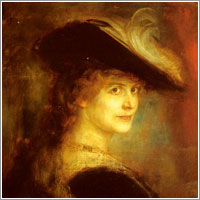 A lady is a woman who is the counterpart of a lord; or, the counterpart of a gentleman. The term Lady can be used as a title.
A lady is a woman who is the counterpart of a lord; or, the counterpart of a gentleman. The term Lady can be used as a title.
Etymology and usage
The word comes from Old English hlaifdige; the first part of the word is laif, loaf, bread, as in the corresponding hlaford, lord; the second part is usually taken to be from the root dig-, to knead, seen also in dough; the sense development from bread-kneader, bread-maker, to the ordinary meaning, though not clearly to be traced historically, may be illustrated by that of lord.
The primary meaning of "mistress of a household" is now mostly obsolete, save for the occasional use of old-fashioned phrases such as "lady of the house." This meaning is retained, however, in the title First Lady, used for the wife of an elected president or prime minister.
The special use of the word as a title of the Virgin Mary, usually Our Lady, represents the Latin Domina Nostra. In Lady Day and Lady Chapel the word is properly a genitive, representing the hlaefdigan.
In the British peerage
As a title of nobility the uses of "Lady" are mainly paralleled by those of "Lord". It is thus a less formal alternative to the full title giving the specific rank, of marchioness, countess, viscountess or baroness, whether as the title of the husbands rank by right or courtesy, or as the lady's title in her own right.
In the case of the younger sons of a duke or marquess, who by courtesy have "Lord" prefixed to their Christian and family name, the wife is known by the husband's Christian and family name with "Lady" prefixed, e.g. Lady John Smith; the daughters of dukes, marquesses and earls are by courtesy Ladies; here that title is prefixed to the Christian and family name of the lady, e.g. Lady Jane Smith, and this is preserved if the lady marry a commoner, e.g. Mr John and Lady Jane Smith.
"Lady" is also the customary title of the wife of a baronet or knight; the proper title, now only used in legal documents or on sepulchral monuments, is "Dame"; in the latter case the usage is to prefix "Dame" to the Christian name of the wife followed by the surname of the husband, thus Dame Jame Smith, but in the former, "Lady" with the surname of the husband only, Sir John and Lady Smith. During the 15th and 16th centuries princesses or daughters of the blood royal were usually known by their Christian names with "The Lady" prefixed, e.g. The Lady Elizabeth.
More recent usage: social class
In more recent years, usage of the word lady is even more complicated. Remarks made by the journalist William Allen White in his 1946 autobiography indicate part of the difficulties. White relates that a woman who had paid a fine for streetwalking came to his newspaper to protest, not that the fact of her conviction was reported, but that the newspaper referred to her as a "woman" rather than a "lady." Since that incident, White assured his readers that his papers referred to human females as "women," with the exception of police court characters, who are all "ladies."
White's anecdote touches on a phenomenon that others have remarked on as well. In the late nineteenth and early twentieth century, in a difference reminiscent of Nancy Mitford's U vs. non-U distinction, lower class women strongly preferred to be called "ladies" while women from higher backgrounds were content to be identified as "women." Alfred Ayers remarked in 1881 that upper middle class female store clerks in his day were content to be "saleswomen," while lower class female store clerks, for whom their job represented a social advancement, indignantly insisted on being called "salesladies." Something of this sense may also be underneath Kipling's lines:
- The Colonel's lady and Rosie O'Grady —
- Sisters under the skin. . .
These social class issues, while no longer on the front burner in the twenty-first century, have imbued the formal use of "lady" with something of an odour of irony.
It remains in use colloquially; for example, as a counterpart to "gentleman," in the phrase "ladies and gentlemen," and is generally interchangeable (in a strictly informal sense) with "woman." (e.g., "The lady at the store said I could return this item in thirty days.")
More recent usage: sexism
Non-sexist language guidelines forbid its use to refer attributively to the sex of a working person, as in lady lawyer and lady doctor. Many find these to have a condescending nuance not shared by female lawyer or woman doctor (should the sex be relevant at all); compare poetess for a similar problem.
Some advocates of non-sexist language recommend not using the word at all, whereas others permit its parallel use in the same circumstances in which a man would be called a gentleman or lord (for example, titling washrooms Men and Ladies would be considered sexist, but using either Men and Women or Ladies and Gentlemen would be acceptable; as is landlady as the parallel of landlord.)
In the United States, notably among younger feminists of the 1990s and 00s influenced by riot grrl, "lady" has occasionally been reclaimed in a more ironic fashion. For example, Miranda July's Joanie 4 Jackie chain letter videotape project is said to consist of "lady-made movies," a feminist music and video distributor in North Carolina called itself Mr. Lady Records, and chorus of Le Tigre's song "LT Tour Theme" from the album Feminist Sweepstakes (2000) declares itself to be written "for the ladies and the fags."